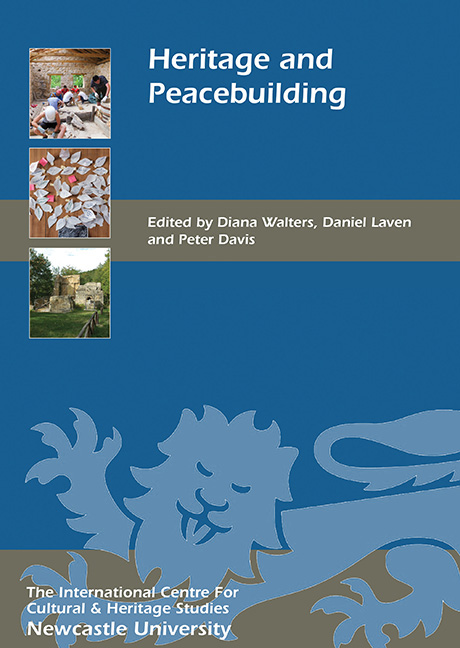Book contents
- Frontmatter
- Contents
- List of illustrations
- Acknowledgements
- List of abbreviations
- Preface
- Introduction
- NEW AND EMERGING IDEAS AROUND HERITAGE AND PEACE
- HERITAGE AND PEACEBUILDING IN PRACTICE
- 7 A Conversation with Sultan Somjee: Conflict and Peacebuilding in Kenya
- 8 Museum, Peace and Reconciliation: the Impact of the Balkan Museum Network
- 9 Diversity, Leadership and Peacebuilding in Museums in the Western Balkans
- 10 Disturbing the Peace: Museums, Democracy and Conflict Avoidance
- 11 Transforming Conflict Through Peace Cultures
- 12 Rethinking Heritage from Peace: Reflections from the Palestinian–Israeli Context
- 13 A Conversation with Will Glendinning: Diversity Challenges in Northern Ireland
- HERITAGE, PEACEBUILDING AND SITES
- List of Contributors
- Index
- Previous Titles
7 - A Conversation with Sultan Somjee: Conflict and Peacebuilding in Kenya
from HERITAGE AND PEACEBUILDING IN PRACTICE
Published online by Cambridge University Press: 16 February 2018
- Frontmatter
- Contents
- List of illustrations
- Acknowledgements
- List of abbreviations
- Preface
- Introduction
- NEW AND EMERGING IDEAS AROUND HERITAGE AND PEACE
- HERITAGE AND PEACEBUILDING IN PRACTICE
- 7 A Conversation with Sultan Somjee: Conflict and Peacebuilding in Kenya
- 8 Museum, Peace and Reconciliation: the Impact of the Balkan Museum Network
- 9 Diversity, Leadership and Peacebuilding in Museums in the Western Balkans
- 10 Disturbing the Peace: Museums, Democracy and Conflict Avoidance
- 11 Transforming Conflict Through Peace Cultures
- 12 Rethinking Heritage from Peace: Reflections from the Palestinian–Israeli Context
- 13 A Conversation with Will Glendinning: Diversity Challenges in Northern Ireland
- HERITAGE, PEACEBUILDING AND SITES
- List of Contributors
- Index
- Previous Titles
Summary
Could you please explain your interest and involvement in peacebuilding – where did it all begin? It was in 1994 when I was the Head of the Department of Ethnography at the National Museums of Kenya that we began talking about peacebuilding using African heritage. Conflicts were raging from Rwanda to Somalia, and tension hung over much of eastern Africa, even in quieter regions. I first started to learn about the heritage of peacebuilding working with four of my assistants, Rigano, Sammi Emwek, Johnston Kasagam and Andrew Cheptum. During the previous 20 years I had done field work on their material culture and had lived among their home communities of Rendille, Turkana and Marakwet peoples. Together we began to explore what material culture was used by their elders in Peace Building and Reconciliation. We enacted the rituals and learnt about the stages of dialogue and variations in the reconciliation processes among the three groups. This naturally flowed into learning about stories, sites and memories of how peace was sustained as a communal heritage.
At about the same time, I had taken up a consultancy with the Mennonite Central Committee (MCC). They were interested in my helping them to identify and collect the material culture of eight of Kenya's pastoralist communities for a travelling exhibition for their own communities across North America. I agreed, but on two conditions. One was that an equal number and quality of items remain in Kenya among all the eight ethnic groups. The other was that I be given an opportunity to train the youth from these eight pastoralist groups to preserve and utilise the collection for education. I saw here an opportunity for the ethnicities – among whom I had worked during the previous 20 years – to keep, manage and transmit their heritage. It was the national and foreign media that controlled and, more often than not, misrepresented minorities’ images and views during conflicts. In the conflicted Kenya of the 1990s it was important that the ethnicities exhibited their own images and views via their heritages. Thus, it became a community project outside of the government-managed cultural institution.
- Type
- Chapter
- Information
- Heritage and Peacebuilding , pp. 71 - 76Publisher: Boydell & BrewerPrint publication year: 2017



